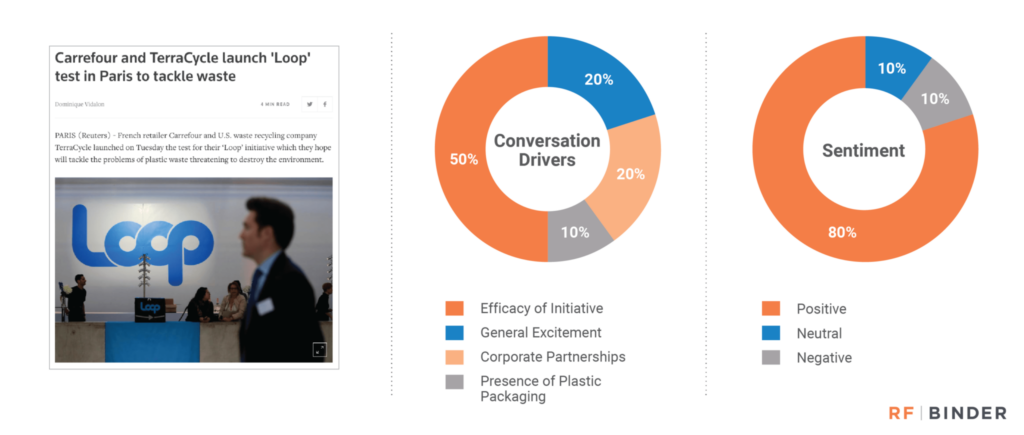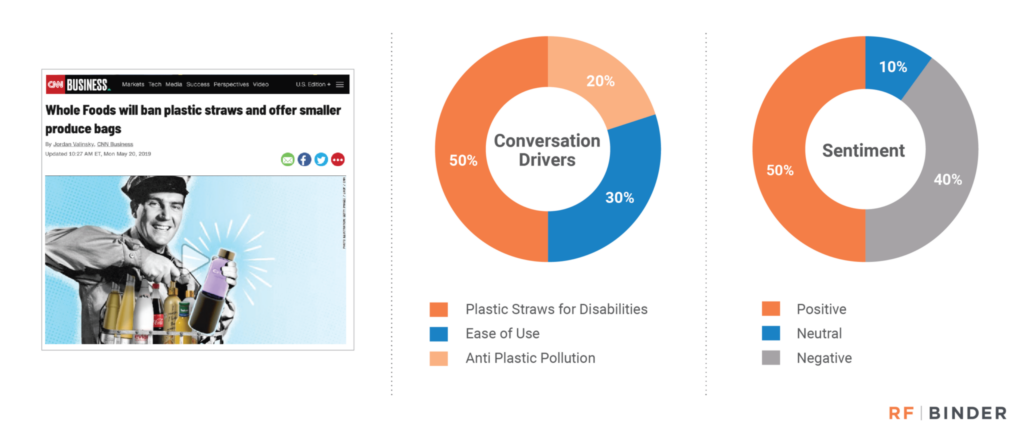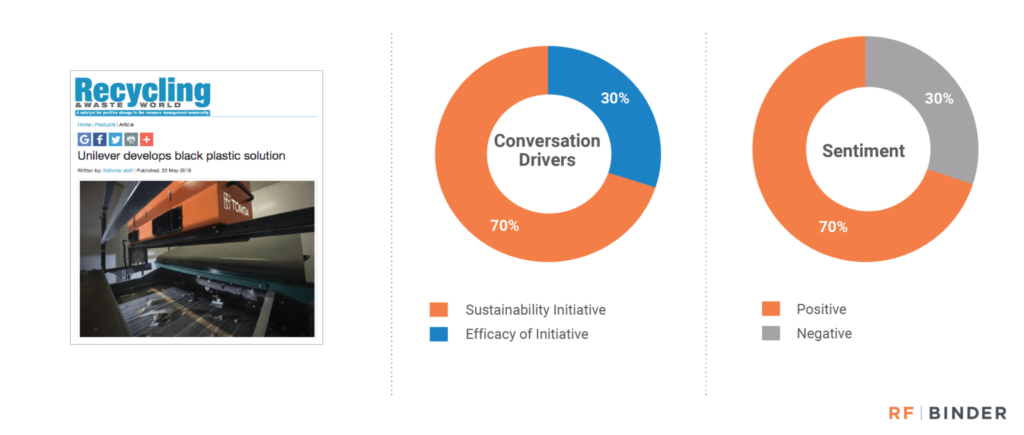The “Good Change” Report is a monthly analysis produced jointly by RF|Binder’s Social Impact & Sustainability and Integrated Planning & Analytics teams. With this report, we provide a look into which brands are driving today’s most important social and environmental conversations, and how the dialogue is taking shape. Each month, we use our proprietary tools to dig into one trending topic, pinpointing the most highly shared news stories, as well as consumer sentiment and key conversation drivers across social media platforms. Read on for this month’s hot topic: single-use plastic.
Wrapped up in Sustainability:
Brands Turn Their Sights on Plastic Pollution
Plastic waste: It’s one of the most significant environmental issues we face today. And it’s also an issue that – even though it’s been around for decades – has spiked in conversation in recent months. Why?
Several recent campaigns have contributed to the trend. Adrian Grenier’s organization, Lonely Whale, launched the “Stop Sucking” campaign, which was instrumental in highlighting the negative impact of disposable plastic straws. The BBC’s Blue Planet documentary, meanwhile, depicted the heartbreaking cost of plastic waste with its shocking visuals of sea animals choking on plastic. Countless other campaigns have similarly contributed to the public‘s heightened awareness and discourse.
Now, as consumer attention and purchasing behavior are increasingly driven by environmental concerns, and as governments have begun enacting environmental policies such as Canada’s and California’s bans on single-use plastic, brands across a wide range of sectors are motivated to get involved.
In our inaugural “Good Change” Report, we explore which companies are trending in conversations related to plastic pollution, and which articles and topics were most highly shared. Our takeaways from this month: There’s always a critic – so be prepared with answers; No solution is too complicated – if you’re doing good, let people know; and put the competition aside – you win when you collaborate with others. Read more on the top stories and our insights below.
Last Month’s Top Stories
LOOP
TerraCycle’s Loop is a great example of competitor collaboration—and also consumer skepticism. In May, the organization rose in the headlines for launching its first test run: a program where consumers can purchase familiar products like Haagen-Dazs and Hidden Valley Ranch in reusable containers, sending them back to Loop for cleaning and reuse once finished. While a good portion of social conversation was consumer excitement for the announcement, many expressed concern over the efficacy of the initiative, questioning its long-term viability and scalability.

Whole Foods
Whole Foods recently announced it would join the long line of companies issuing bans on single-use plastic straws. However, the ban came with a caveat: single-use plastic straws would remain available for request by those with a disability. The response was mixed–some argued that this creates an unnecessary barrier, while others praised Whole Foods for keeping the option open for those who need it.

Unilever
Recycling black plastic has been a tough problem to solve in the industry; scanners often can’t detect the black pigment to recycle. Recently, Unilever developed a new detectable black pigment for its High Density Polyethylene (HDPE) bottles (think Axe body spray) so they can now be ‘seen’ by recycling plant scanners and sorted for recycling. Unilever’s public communications surrounding this initiative offers a great example of how brands can effectively share news about virtually sustainable solutions, no matter how complicated, using visualizations and simplified language.

Our Big Takeaways
1. There’s always a critic – so be prepared with the answer
In every top plastic reduction initiative, consumers questioned brands on the feasibility and impact of the proposed solution. That said, it’s important for brands to proactively identify and address anticipated concerns in your early communication. Don’t just tell people about the goals—get into the details, and proactively explain to your audiences how it’s adoptable, scalable and effective. They don’t want to do the guesswork. Plus, the people who support progress usually outnumber those who who stall it – keep your eye on the prize!
2. No solution is too complicated – if you’re doing good, let people know
Overall, regardless of if consumers felt a new plastic initiative was confusing or complex, general conversation sentiment remained positive for all three brand conversations analyzed. The key takeaway? While consumers may have myriad of questions in response to a new plastic production initiative, it’s still important to share significant operational or supply chain shifts that help address the plastic problem. Through visualizations and creative marketing, brands can create effective educational materials that teach consumers the relevance, importance and impact of their solution, driving positive conversations for the brand.
3. Put the competition aside – you win when you collaborate with others
Corporate partnerships drove 20% of the conversation for Loop—and they were mostly positive, commending the organization for bringing together competitive organizations to drive a scalable solution. Collaborations help streamline efforts to solve global or industry problems, push the needle farther faster, and generally ensure brands aren’t wasting precious time trying something that already failed. Gone are the days of siloed social impact programs driven for solely reputational purposes. Companies know that when they work together, they can drive industry-wide solutions like a new, less impactful coffee cup or new version of plastic bags—and consumers respond well to a kind of collaboration that drives both purpose and profit.
For questions about our report or to discuss our findings and methodology further, you can e-mail RF|Binder’s Social Impact & Sustainability team at sis@rfbinder.com.

